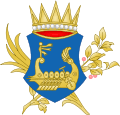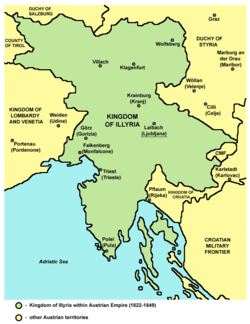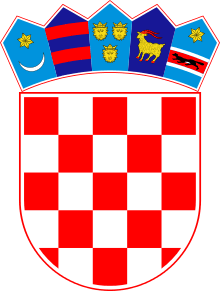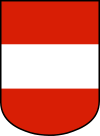Kingdom of Illyria
The Kingdom of Illyria was a crown land of the Austrian Empire from 1816 to 1849,[1] the successor state of the Napoleonic Illyrian Provinces, reconquered by Austria in the War of the Sixth Coalition and restored according to the Final Act of the Vienna Congress. Its administrative centre was in Ljubljana (officially German: Laibach)
Kingdom of Illyria | |||||||||||||
|---|---|---|---|---|---|---|---|---|---|---|---|---|---|
| 1816–1849 | |||||||||||||
 Flag
 Coat of arms
| |||||||||||||
 Kingdom of Illyria within the Austrian Empire (1822-1849) | |||||||||||||
| Status | Crown land of Austria | ||||||||||||
| Capital | Ljubljana | ||||||||||||
| Common languages | Italian, Slovene, Croatian, German | ||||||||||||
| Religion | Roman Catholic | ||||||||||||
| Government | Monarchy | ||||||||||||
| King | |||||||||||||
• 1816–1835 | Francis I | ||||||||||||
• 1835–1848 | Ferdinand I | ||||||||||||
• 1848–1849 | Francis Joseph I | ||||||||||||
| Statthalter | |||||||||||||
| Historical era | Modern history | ||||||||||||
| 3 August 1816 | |||||||||||||
| 8 December 1849 | |||||||||||||
| Currency | Thaler | ||||||||||||
| |||||||||||||
| Today part of | |||||||||||||
Upon the Revolutions of 1848, the kingdom was dissolved and split into the Austrian crown lands of Carniola, Carinthia and the Austrian Littoral.
Geography
The French Illyrian Provinces had comprised Carniola and western ("Upper") Carinthia as well as the Adriatic territories of Gorizia and Gradisca, Trieste and the Istrian peninsula. They had also included the Dalmatian coast and the lands of the Kingdom of Croatia south of the Sava River. Parts of the territories on the Adriatic Sea had been annexed by the Habsburg Monarchy from Venice in the 1797 Treaty of Campo Formio. Upon the dissolution of the Provinces, the Austrian government split-off Dalmatia and merged the eastern ("Lower") part of Carinthia into what was to become the Kingdom of Illyria.
The territory of the kingdom included the western and central part of present-day Slovenia, i.e. Carniola with the capital Ljubljana and the Slovenian Littoral (Goriška and Slovenian Istria), the present Austrian state of Carinthia and Slovenian Carinthia, as well as some territories in north-western Croatia (present-day Istria County and the Kvarner Gulf islands of Krk, Cres and Lošinj) and north-eastern Italy (the Provinces of Trieste and Gorizia). In 1822, Civil Croatia between the right bank of the Sava and Rijeka was again merged into the Habsburg Kingdom of Croatia.
History
The Kingdom of Illyria was formed to counter the territorial pretenses of the Kingdom of Hungary and the influences of the Russian Empire, but with the Hungarian annexation of the Civilian Croatia and Rijeka lost on its significance.[1] The legal and administrative reforms made by the former French authorities deeply transformed the administrative structures of these territories, so the Austrian Imperial authorities thought it better to group most of them as a separate administrative entity, enabling a slow incorporation into the Austrian legal, judicial and administrative system.
The Kingdom of Illyria was officially established on 3 August 1816.[2] In the first years, it also included Croatian territory that was part of Napoleonic Croatie civile. Already in the early 1820s, however, the pre-Napoleonic Croatian kingdom was re-established, in which also the territories forming part of the Kingdom of Illyria were included (the city of Rijeka-Fiume with eastern Istria and the province of Karlovac).
.jpg)
In the Spring of Nations in 1848, Slovenes advanced a proposal to include Lower Styria in the Kingdom of Illyria, so most of the Slovene Lands would be united in a single administrative entity and the idea of a United Slovenia would thus be achieved. Peter Kozler designed a map of such an enlarged Kingdom of Illyria, which would later become an important national symbol in the Slovenian national consciousness. The proposal was, however, rejected by the Habsburg Emperor. The Kingdom of Illyria was gradually mentioned less and less and for the last time officially appeared in 1849 as a crown land in the March Constitution of Austria.[1]
Administration
From 1822 to 1848 it was administered by the Imperial-Royal Government in Ljubljana (Laibach) for the Kreise (provinces) of Ljubljana, Novo Mesto (Neustadt), Postojna (Adelsberg), Villach (Beljak) and Klagenfurt (Celovec) and the Imperial-Royal Government for Littoral in Trieste for the Kreise of Istria (Istrien), Gorizia (Görz) and the imperial city of Trieste.
See also
References
- Vidic, Marko, ed. (2000). "Ilirsko kraljestvo" [Kingdom of Illyria]. Ilustrirana zgodovina Slovencev [The Illustrated History of the Slovenes]. Mladinska knjiga. p. 213. ISBN 86-11-15664-1.
- "3. avgust" [3 August]. Delo.si (in Slovenian). 2 August 2006.
Sources
- Haas, Arthur G. (1963). Metternich, Reorganization and Nationality, 1813-1818: A Story of Foresight and Frustration in the Rebuilding of the Austrian Empire. Wiesbaden: Franz Steiner Verlag.CS1 maint: ref=harv (link)
External links
- Map of Illyria
- Kingdom of Illyria (at worldstatesmen.org)


